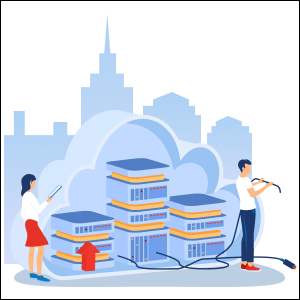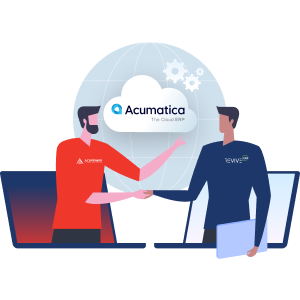
Demystifying IaaS vs PaaS vs SaaS: Deciphering Cloud Service Models for Digital Acceleration
Cloud computing has ushered in ubiquitous access to on-demand technology resources, fundamentally changing how organizations architect digital solutions. With accelerating cloud adoption across industries, unpacking the spectrum of cloud service delivery models available is essential for IT leaders to optimize their cloud technology strategy. And, of course, it influenced the ERP industry quite significantly.
This definitive guide provides an in-depth look at the three major cloud computing service models – Infrastructure-as-a-Service (IaaS), Platform-as-a-Service (PaaS), and Software-as-a-Service (SaaS). We’ll deeply explore the capabilities and differences between IaaS vs. PaaS vs. SaaS to inform cloud architecture decisions for enabling digital business transformation.

IaaS: Flexible Cloud Infrastructure Provided as a Service
Infrastructure-as-a-Service (IaaS) constitutes the most flexible cloud computing model, offering on-demand access to fundamental IT infrastructure resources hosted in the public cloud yet manageable privately. IaaS provides the instant provisioning of cloud servers, networking, storage hardware, and data center facilities from leading “hyperscale” IaaS providers like Amazon Web Services (AWS), Microsoft Azure, Google Cloud Platform (GCP), and IBM Cloud.
Rather than installing physical data center hardware themselves, with convenient self-service IaaS dashboards, enterprise IT teams can immediately configure and launch cloud-based virtual servers, storage, network capacity, and other infrastructure building blocks when needed. This cloud-hosted “virtualized infrastructure” appears as a private environment to architects with remote management capabilities yet is backed by the underlying physical public cloud data centers shared securely between providers’ customers.
Prominent examples of vital cloud IaaS infrastructure include Amazon Elastic Compute Cloud (EC2) resizable virtual machines for Windows or Linux, Azure Virtual Machines, Google Compute Engine instances, and IBM Cloud Bare Metal Servers. Additional essential IaaS components incorporate cloud storage like Amazon Simple Storage Service (S3) and Azure Blob Storage, virtual private networks like AWS Virtual Private Cloud (VPC), and Google VPC for connecting resources, along with cloud data centers across geographic availability zones for resilience.
Overall, IaaS delivers unprecedented IT infrastructure agility since organizations don’t have to invest predictively in physical on-premises hardware they may underutilize or that could become obsolete quickly. The real-time ability to spin infrastructure capacity up or down dynamically based on granular workload demand allows for optimizing cloud computing costs precisely according to fluctuating business needs.
The automation and usage-based pricing model of IaaS boosts responsiveness and productivity by accelerating delivery of technology projects without lengthy capital budgeting delays upfront. By adopting IaaS services, enterprises modernize from rigid static IT infrastructure Constraints to flexible, instantly accessible cloud resources that adapt on pace with digital initiatives and scale elastically to fuel growth opportunities.
Key IaaS Cloud Computing Characteristics:
- On-Demand Self-Service – Infrastructure capacity provisioned immediately via automated dashboards without human administration delays
- Broad Network Access – Cloud resources are accessible conveniently over the public internet from anywhere with credentials
- Resource Pooling – The provider’s massive underlying physical infrastructure abstracted as shared customizable virtual resources
- Rapid Scalability – Infrastructure capacity is adjusted up or down quickly through software to align with workload dynamics
- Measured Service – Usage of exact cloud resources consumed tracked with transparency for metered billing
Customer Benefits of IaaS Cloud Solutions:
- Avoid CapEx Costs – Utilize Opex pricing with no major upfront infrastructure expenses
- Increase IT Responsiveness – Deploy new infrastructure swiftly without lengthy hardware procurement
- Gain Cloud Capabilities – Leverage the latest x86 servers with cutting-edge remote management interfaces
- Simplify Hybrid Infrastructure – Extend and migrate existing systems more easily to IaaS initially
By leveraging IaaS building blocks from hyperscale providers, enterprise IT teams gain cloud capabilities faster via instantly scalable infrastructure resources that maximize operational agility and spending efficiency – both vital to digital transformation.
PaaS: Application Platforms Provided as Cloud Services
While IaaS offers direct access to fundamental cloud infrastructure blocks, Platform-as-a-Service (PaaS) provides integrated cloud computing environments for building, launching, and managing custom software applications without configuring the underlying resources. Well-known PaaS platform examples include AWS Elastic Beanstalk, Microsoft Azure App Service, Google App Engine, and Red Hat OpenShift.
These preconfigured public cloud application platforms automate coordinating and interconnecting essential OSes, middleware, databases, storage, networking, and DevOps CI/CD tooling together underneath into unified PaaS services. Cloud architects simply upload their application code repositories directly to the managed PaaS environments to streamline building SaaS-style applications faster at scale without manually installing and orchestrating infrastructure components.
Additionally, pre-integrated on-demand cloud capabilities are available as part of PaaS platforms for adding common application features like AI, machine learning, event streaming, blockchain, IoT integration, and data analytics. These high-level application cloud services further accelerate development using simple API calls. Organizations leveraging PaaS solutions can focus exclusively on crafting compelling digital experiences rather than wrestling with infrastructure integration issues during custom software projects.
For cloud-native development groups, PaaS allows concentrating efforts strictly on rapid programming and UX design innovations for customers rather than downward-facing infrastructure management burdens. Enterprise PaaS cloud computing offerings minimize undifferentiated platform engineering heavy lifting while empowering small teams to sustain high solution output and business value.
Key PaaS Platform Cloud Characteristics:
- Integrated Middleware – OS, programming language stacks, databases and caching layers preconfigured
- Automated CI/CD Pipelines – Cloud DevOps tooling baked-in for continuous code testing and deployment
- Multi-Tier Load Balancing – Auto-scaling of web, application and database platform layers
- High-Availability Architecture – Redundant infrastructure across multiple availability zones to assure 24/7 operation
- Embedded Analytics – Cloud monitoring and logging visibility into platform and application performance
- Turnkey Add-Ons – Out-of-the-box integration of messaging, IoT, blockchain and machine learning capabilities
Customer Benefits of PaaS Cloud Solutions:
- Increase Developer Productivity – Eliminate time spent installing and stitching together disparate platform components
- Improve Operational Agility – Streamline DevOps workflows for continuous cloud application deployment and upgrades
- Enhance Innovation Velocity – Add advanced features like AI quickly through API integration to respond to users and markets
- Maximize Business Value – Release technology projects faster and shift more investment to client-facing capabilities over infrastructure
PaaS cloud computing models allow enterprise application teams to boost productivity dramatically when building cloud-native solutions, web apps, and mobile apps by leveraging managed platforms specialized for scale, speed, and resiliency.
SaaS: Software Delivered Through the Cloud
In contrast to IaaS and PaaS, which provide flexible underlying infrastructure and platforms for custom-built applications, Software-as-a-Service (SaaS) represents finished business software products hosted in the cloud and accessible to users directly on demand over the internet. SaaS eliminates the need for customers to install, configure, and manage complex software suites traditionally requiring maintenance, troubleshooting, and version migration.
Widely used SaaS applications today include ubiquitous productivity tools such as Microsoft 365 and Google Workspace Docs for documents and spreadsheets accessible through web browsers and mobile apps. Specialized software capabilities are also offered SaaS-style, such as customer relationship management (CRM) with Salesforce, human resources (HR) systems using Workday, project management via Asana, email marketing software from MailChimp, help desk ticketing systems like Zendesk, Adobe Creative Cloud design tools and infinite other solutions.
These full-featured SaaS applications run entirely within the infrastructure of hyper scale cloud providers like AWS, Microsoft Azure, GCP, or Oracle Cloud but are managed, maintained, continuously updated, and secured by independent software vendors (ISVs). Users conveniently access the rich functionality of the latest software versions through client web browsers or lightweight mobile apps with no local installation required.
For enterprise IT administrators, SaaS liberation from substantial testing, patching, upgrades and support burdens associated with on-premises software deployments across corporate endpoints. IT can easily spin up additional software subscriptions as needed through cloud provider APIs and leave license plus configuration complexities to SaaS providers. Business users access innovation quickly while cloud economics enable usage adjust to market changes.
Key SaaS Cloud Computing Characteristics:
- Centralized Hosting – SaaS software applications installed and operated only within vendors’ cloud infrastructure
- Universal Access – Employees utilize SaaS software conveniently via web browsers without location restrictions
- Multi-Tenancy – Shared public cloud resources utilized securely across customer organizations with data isolation
- Automatic Upgrades – Cloud vendors responsible for ongoing SaaS product enhancements, patching, and maintenance
- Mobile App Integration – Native and responsive mobile application access tied to SaaS offerings with offline modes
Customer Benefits of SaaS Cloud Solutions:
- Reduce Software Maintenance – No need to install, configure, and manage software apps onsite with SaaS
- Enhance Employee Productivity – Users stay updated automatically with the latest feature-rich SaaS software
- Streamline Licensing – Consolidate multiple software vendor relationships by adopting integrated SaaS suites
- Improve Business Agility – Scale up software subscriptions quickly through cloud provider self-service
By moving from traditional on-premises software portfolios to SaaS-delivered cloud applications, enterprise IT environments gain numerous operational efficiencies related to cloud automation, staff productivity and infrastructure cost reductions over maintaining corporate data centers just for software alone.
Comparing IaaS, PaaS, and SaaS Cloud Service Attributes
Now that we’ve done deep dives into Infrastructure-as-a-Service (IaaS), Platform-as-a-Service (PaaS), and Software-as-a-Service (SaaS), let’s compare their positions across a spectrum spanning infrastructure control, complexity, and business value focus.
| IaaS | PaaS | SaaS | |
|---|---|---|---|
| Infrastructure Scope | Servers, Storage, Networking, OS | Integrated App Platform Layer | Full SaaS Applications |
| Admin Control | Full Admin Access | Limited Config Access | No Access – fully managed |
| Upfront Effort Level | Low – instant infrastructure | Low/Med – build code to platforms | None – subscribe to apps |
| IT Skill Needs | DevOps, Cloud Engineers | Developers, Cloud Architects | End Users |
| Ongoing IT Effort | High Admin Responsibility | Med Platform Responsibility | Low – Fully Managed SaaS |
| Cloud Cost Factors | Reserved Instance Discounts | Node Density Optimization | User Profile Planning |
| Hyperscale Cloud Role | Enabler – Infrastructure Builder | Accelerator – Platform Manager | Channel – App Publisher |
| Business Value Focus | IT Agility and Efficiency | Developer Productivity | Employee Experiences |
Evolution across the cloud continuum progresses from flexible infrastructure (IaaS), to accelerated application development (PaaS), to business-driving SaaS software capabilities. Likewise, control and effort shift from hands-on admins to empowered users.
IaaS offers the most personalization around utilizing raw cloud infrastructure like configurable VMs, storage, and networking yet requires ongoing resource administration and orchestration between elements.
PaaS provides prebuilt development stacks, services, and cloud DevOps automation to simplify application creation on managed platforms but allows only limited tailoring access below platform layers.
SaaS delivers complete turnkey business software application functionality without installation yet lacks behind-the-scenes personalization as vendor-driven.
Ultimately, IaaS lays the adaptable infrastructure groundwork, PaaS enables rapid custom software builds, and ubiquitous SaaS amplifies solutions accessibility for employees. Together, they provide a ladder to cloud-powered advancement.
Closing Recommendations on Adopting Cloud Service Models
Every enterprise cloud journey should thoughtfully incorporate elements spanning infrastructure versatility, platform velocity, and software innovation across the technology stack:
Establish IaaS Foundations – Introduce initial IaaS building blocks first, like cloud VMs, storage, and networking, to increase infrastructure agility, making on-prem systems easier to interconnect or migrate in a hybrid fashion.
Evaluate PaaS Potential – Assess whether managed PaaS services fit certain application portfolio modernization scenarios faster to boost developer productivity on cloud-native builds.
Embrace SaaS Solutions – Catalog and strategically shift suitable software systems to leading SaaS alternatives to improve end-user and customer experiences continually.
Unify Management – Connect cloud management and governance across chosen IaaS, PaaS, and SaaS environments for cohesion, leveraging integration technologies and unified visibility.
Innovate Responsibly – Balance the speed of cloud innovation for the business with responsible development, spending, and security policies that align with corporate standards.
The cloud arena continues rapid expansion with new hybrid deployment patterns leveraging combinations of IaaS flexibility, PaaS velocity, and SaaS solutions, creating adaptable models for the future. Organizations that creatively incorporate elements across cloud infrastructure, platforms and software can accelerate digital transformation and sustainable competitive advantages in the marketplace.
Conclusion
In case you feel that the description of all cloud service models, providers, modules, etc, made you scared, there is no need to worry. Our team, AcuPower, will be happy to provide you with Cloud ERP Acumatica, which utilizes the needed features of the cloud infrastructure. Also, you can be sure that your cloud will be taken care of well and maintained in a secure fashion.
Comments (0)
No comments yet
Be the first to comment
 Share on Facebook
Share on Facebook
 Share on LinkedIn
Share on LinkedIn
 Share on Twitter
Share on Twitter



 1395
1395

